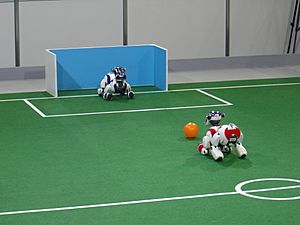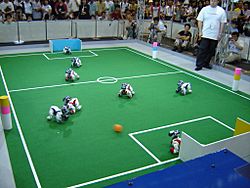AIBO facts for kids
 |
|
| Manufacturer | Sony Corporation |
|---|---|
| Inventor | SONY's Digital Creatures Lab and Toshitada Doi |
| Country | Japan |
| Year of creation | 1999 |
| Type | Dog |
| Purpose | Entertainment |
| Website | http://aibo.com |
AIBO (which means "Artificial Intelligence Robot") is a cool series of robotic dogs. Sony, a famous Japanese company, designed and made them. The name "AIBO" also sounds like the Japanese word aibō, which means "pal" or "partner."
Sony first showed a test version of AIBO in 1998. The very first AIBO that people could buy came out on May 11, 1999. New models were released almost every year until 2006. Even though most AIBOs looked like dogs, some designs were inspired by lion cubs or different dog breeds like huskies or terriers.
In 2006, AIBO was honored by being added to the Carnegie Mellon University Robot Hall of Fame.
On January 26, 2006, Sony announced they would stop making AIBO. This was part of a plan to help the company earn more money. Sony slowly stopped helping customers with their AIBOs. Support for the last model, the ERS-7M3, ended in March 2013. By July 2014, Sony no longer offered repairs for any AIBO robots.
But good news! In November 2017, after 11 years, Sony announced a brand new AIBO. This fourth-generation model, called the ERS-1000, was launched in Japan on January 11, 2018.
Contents
Meet the AIBO Models
Early AIBO Ideas
Sony showed off a few test versions of AIBO before the first one was released. Some of these early ideas looked like insects with six legs! The first AIBO that was sold to the public was very similar to the 1998 test model.
First AIBO Generation (11x)
ERS-110
This was the very first AIBO that people could buy. It looked a bit like a beagle dog. Sales started on June 1, 1999. Only a small number were made: 3,000 for Japan and 2,000 for the USA. These are now considered quite rare. They sold out online in just 20 minutes! The ERS-110 was silver with a golden-brown color and gray claws. It cost about $2,500 back then.
ERS-111
The ERS-111 was an improved version of the first AIBO. It came out in November 1999. Sony made 40,000 units in total. It cost the same as the ERS-110. It looked similar to the ERS-110 but had different ear and tail shapes. It came in shiny silver with black claws or a metallic black color.
Second AIBO Generation (2x0)
ERS-210
The ERS-210 was designed to look like a lion cub, but many people thought it looked more like a dog, perhaps a Jack Russell terrier puppy. This model could understand spoken words. It came in many colors: black, silver, gold, red, blue, green, and white. The ERS-210 is the most common and popular AIBO model, with over 65,000 units sold. It cost about $1,500 when it first came out.
ERS-220
This AIBO was silver and had a cool, futuristic design. It was inspired by space exploration robots. The ERS-220 was very similar to the ERS-210, but its outside shell looked different. About 5,000 to 7,000 units were sold. You could even control it from far away using an optional Wi-Fi card.
ERS-210A/220A
These were updated versions of the ERS-210 and ERS-220. They looked almost the same but had a better computer (CPU) inside. They also had a special "Super Core" sticker on the bottom. They cost about $1,299 when they were launched.
Third AIBO Generation (31x)
ERS-31x (Latte and Macaron)
The ERS-31x models had a slogan: "AIBO's heart." They cost about $950.
- The "Latte" (ERS-311) was off-white or cream colored. It was known as the "friendly" model.
- The "Macaron" (ERS-312) was mostly black with cream parts. It was considered the "naughty" model.
- The "Pug" (ERS-31L) was brown and the rarest of the three. It was also $200 cheaper.
These 31x series AIBOs looked like a Bichon puppy or a bear cub.
ERS 31xB
These models looked just like the earlier 31x models. However, they had a special Bluetooth chip added. This allowed them to connect with a "Handy Viewer" device in Japan. The Handy Viewer could show what the AIBO was "thinking" or "feeling" as text. It also let owners play games with their AIBO. The ERS-31L "Pug" model did not get this Bluetooth update.
Fourth AIBO Generation (7Mx)
About 40,000 to 50,000 of all ERS-7 models were sold.
ERS-7
Released in November 2003, this AIBO is seen as the best of the original series. It was one of the first AIBOs that truly looked like a dog, similar to the 110/111 models. It came in white and cost about $1,599. This was also the first AIBO model that could talk in all its versions, without needing special software.
ERS-7M2
This was the second version of the ERS-7, released in November 2004. It was available in black or white.
ERS-7M3
The ERS-7M3 came out in October 2005. It was an updated version of the ERS-7M2. This AIBO could speak both English and Japanese. Its personality would change slightly based on how you interacted with it and its surroundings. This was the last AIBO model made before the line was stopped in 2006.
The main differences between the ERS-7 models are small. The second and third versions used lead-free parts. They also came with different software, but you could swap them if you wanted. The third version also had updated Wi-Fi.
Fifth AIBO Generation
ERS-1000
This is the newest AIBO model, released in January 2018. It was the first new AIBO since the original project ended in 2006. This AIBO needs to be connected to the internet to work fully. It comes with a special SIM card and a monthly service. This helps it learn and interact using cloud technology.
The ERS-1000 looks much cuter than most older models. It can recognize up to 100 faces and remember a special trick you teach it. It also responds to over 50 voice commands. It costs around $3,000.
How AIBO Works (Hardware)
The first AIBO, the ERS-110, had a powerful computer chip inside. It also had 16 megabytes of memory (RAM). AIBOs had many sensors to understand their world. These included:
- Touch sensors (to feel when you pet them)
- A camera (to "see")
- A range-finder (to know how far away things are)
- A microphone (to "hear")
- Sensors for movement (to know if it's moving or falling)
AIBOs also had a speaker and parts that helped them move, like their legs, neck, mouth, and tail. As new AIBO models came out, they got even more sensors and moving parts. Some second-generation AIBOs could even connect to Wi-Fi. The ERS-7 models had many sensors on their head and body, special "Illume-Face" lights to show feelings, and Wi-Fi.
All AIBOs came with things like a charging station and a pink ball toy. Later ERS-7 models also came with a bone-shaped toy called an AIBone, playing cards, and a charging station that helped them find their way back to charge themselves.
AIBO's Brain (Software)
All AIBOs came with special software called AIBOLife. This software gave the robot its own personality. It allowed AIBO to walk, "see" with its camera, and understand spoken commands in English, Spanish, or Japanese. The sounds AIBO made were created by a Japanese artist, mixing robot and natural sounds.
AIBOware
Older AIBO models (first and second generation) could use different software packages sold by Sony. This software was called AIBOware. It came on a pink Memory Stick.
- The Life AIBOware let you raise your robot from a puppy to an adult. It would go through different stages as you played with it.
- The Explorer AIBOware let you interact with a fully grown robot that understood many voice commands.
Without AIBOware, AIBOs could only do very basic actions.
The newer ERS-7 models had one main software called "Mind." This Mind software included all the features of the older AIBOLife and other AIBOware packages. It also allowed the ERS-7 to go back to its charging station by itself to recharge. Later versions of Mind software added Wi-Fi connection to a computer, speech, and the ability to map out a room.
AIBO's vision system used a special algorithm (a set of rules) to recognize its charging station.
AIBOs in Learning and Research
AIBOs were used a lot in schools and universities. For example, some universities taught courses using AIBOs to learn about how robots "see," "think," and move.
RoboCup Robot Soccer League
AIBOs were very popular for teaching and research in artificial intelligence. This is because they had a computer, a vision system, and moving parts all in one package. This made them much cheaper than other research robots. A big part of this was the RoboCup Leagues.
The Four-Legged League was a robot soccer league where all teams used the exact same robots. The robots played by themselves, without any human control. Different AIBO models were used over the years: ERS-110s, ERS-210, ERS-210A, and ERS-7. This league ran from 1999 to 2008. After that, a new humanoid robot called NAO became the standard robot for the competition.
Sony helped universities around the world by giving them AIBOs to join the RoboCup robot soccer competition. Teams would program their AIBO robots to play soccer games against other teams. The University of New South Wales was the most successful team in this league, winning three times!
International AIBO Convention
Every year, there's a special event called the International AIBO Convention. It usually takes place at Sony Robotics Tower in Japan. The first convention was in 1999. These events often feature new AIBO ads, free posters, free accessories, and "AIBO Shows" where the robots perform.
AIBO Family Tree
First Generation Models
- ERS-110: silver; released June 1, 1999. Limited numbers made.
- ERS-111: silver and black; released November 1999.
About 65,000 first-generation AIBOs were sold in total.
Second Generation Models
- ERS-210: came in black, gold, and silver (2001). Later, special colors like Spring White, Everest White, and Sapphire Violet were released.
- ERS-210A "Supercore": came in black, gold, and silver (2002). Later, special colors like Holiday Red and Cyber Blue were released.
- ERS-220: silver; released 2002.
Third Generation Models
- ERS-311 "Latte": cream; released 2001.
- ERS-312 "Macaron": black; released 2001.
- ERS-31L "Pug": brown; released 2002.
- ERS-311B "Latte": cream; released 2002 (with Bluetooth).
- ERS-312B "Macaron": black; released 2002 (with Bluetooth).
Fourth Generation Models
- ERS-7: white; 1st version, released November 2003.
- ERS-7M2: white and black; 2nd version, released November 2004.
- ERS-7M3: white, black, and champagne gold; 3rd version, released October 2005.
About 40,000 to 50,000 ERS-7 AIBO models were sold in total.
Fifth Generation Models
- ERS-1000: ivory white; released January 2018.
- ERS-1000: choco edition; released January 2019.
- ERS-1000: caramel edition; released January 2020.
- ERS-1000: black sesame edition; released January 2021.
AIBO in Cartoons
There was an AIBO cartoon called Piroppo (ピロッポ). It was based on the AIBO ERS-300 models, Latte and Macaron. If you had the right software, the cartoon could even make your ERS-300 AIBO make sounds and do actions while you watched!
The cartoon had 23 episodes and was shown in Japan from October 11, 2001, to March 21, 2002.
Images for kids
See also
 In Spanish: Aibo para niños
In Spanish: Aibo para niños








